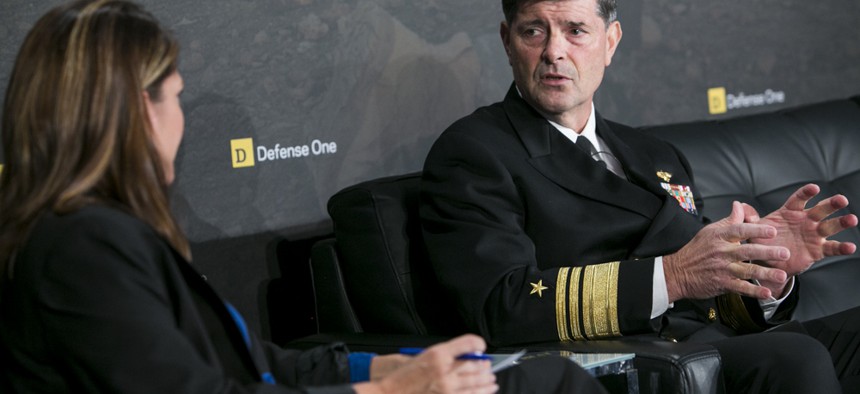
Vice Adm. William Moran chats with Defense One Managing Editor Stephanie Gaskell at the annual Defense One Summit. Kristoffer Trippelaar/Defense One
Navy May Allow Sailors To Take a Break From the Military
The chief of naval personnel says the service needs to adapt to the changing job market. By Marcus Weisgerber
The Navy is looking for a way that would allow sailors to leave the military and easily return to active-duty after getting degrees or working in the private sector, a top admiral said Wednesday at the Defense One Summit.
The move would allow the Navy to save money on training new sailors in high-tech career fields.
“We want to keep as much of this combat experienced force as we can,” Chief of Naval Personnel Vice Adm. William Moran, chief of naval personnel, said.
This includes special forces, sailors in the technical nuclear field, missile defense, and “any field that takes us two to three years to train the person to be ready to operate in that environment,” Moran said.
If a sailor does not commit to a 20-year military career after five-to-eight-year mark of service, the Navy typically says: “Thank you for your service and then move[s] on.”
“I’m not sure that we can afford to do that in the future,” Moran said. “It costs a lot to bring people in. It costs a lot to train people from the ground up, so I would like to see us move toward a system that allows people to have an off ramp from service.”
This would allow sailors to get a college degree, start a family, get a job and “see what the world’s like on the other side,” Moran said. The Navy could then have an “on ramp” to bring these sailors back into the military.
By bringing these folks back into the Navy, the service could save “an enormous amount on training” and have a “more mature, more experienced sailor, when they come back,” Moran said.
This is similar to the way the Naval reservists operate, where a small number of sailors go from the Reserves into active-duty. “Small numbers today, but if you could grow that into a bigger rotation, I think we could attract more young men and women who want to make it a longer-term career than just one tour, five years and out,” he said.
NEXT STORY: What the US Navy of the Future Looks Like





